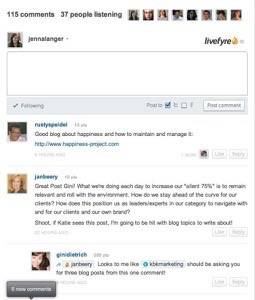Commenting system Livefyre has announced version 2.0 of its platform, introducing new features to bring conversations from the social Web into on-site comments. SocialSync grabs related Twitter and Facebook comments automatically, so there’s always a conversation on the page, even if no one has commented yet directly. It also adds @ mentions from within the comment box, allowing users to tag and notify their friends on those services, drawing them into the conversation.

“Everything we’re doing is about increasing engagement on publisher content,” says Livefyre CEO Jordan Kretchmer. By drawing in conversations from where they’re happening on the social Web, Livefyre sites will become the hubs of conversation about their own content again. People who prefer to chat on social networks can still be involved, but sites will still benefit from those conversations on their own pages. Twitter and Facebook are built in at launch, and Google Plus is coming soon.

The most important SocialSync feature for publishers is the automatic capturing of related comments on outside networks. When anyone shares or talks about an article on Facebook or Twitter, the comment thread on the article itself will automatically grab that comment and pull it in.
Twitter conversations are particularly hard to capture. Not only do they fly by in real time, they’re scattered and incomplete. Many sites, ourselves included, love to use Storify to curate tweets manually, but the torrent of tweets can be too much to manage sometimes. Livefyre’s new features can reduce that burden by grabbing related tweets automatically.
Facebook and Google Plus – which Kretchmer says is coming to Livefyre soon – are great for threaded conversations, but for that very reason, important conversations happen on those networks totally outside the confines of the original site. Those conversations represent huge value for publishers, and SocialSync will help sites that use Livefyre recapture it.

Kretchmer says the Livefyre database tracks the different sources of the comments underneath. To simplify the interface, Livefyre displays only one total number of comments. For comment threads themselves, publishers have a choice: they can separate out Twitter and Facebook comments from the on-page blog comments, or they can have one unified stream with just a small indicator of a comment’s source.
The overall design of the commenting system can be styled to the publisher site. Kretchmer also says the system works “perfectly” on mobile sites. Real-time comment streaming, sign-in and sign-up through Livefyre or other social networks, and all its other desktop features work fine on mobile as well.

SocialSync is good for content strategy, because it will make the article page a more definitive location for users and search engines alike. But it’s also good for community. It will take away that lonely feeling of coming to a blog post and seeing 0 comments. Kretchmer says that Livefyre helps publishers vastly increase the volume of comments and shares, creating valuable engagement between readers and staff, as well as driving traffic and increasing relevance to search.
Comments Are Part of the Story
Social networks have tried to provide this service themselves. Facebook offers a third-party commenting system, but it’s not gaining much traction, and Twitter offers a range of resources to add value to publisher sites. But commenting services like Disqus – which we use here at RWW – and Livefyre let sites and their users use whatever channels they want for their conversations. Livefyre 2.0 and SocialSync will be great for publishers who want conversations to flourish without getting away from the stories that start them.
What makes a good comment thread? Start one here, and let’s discuss!










